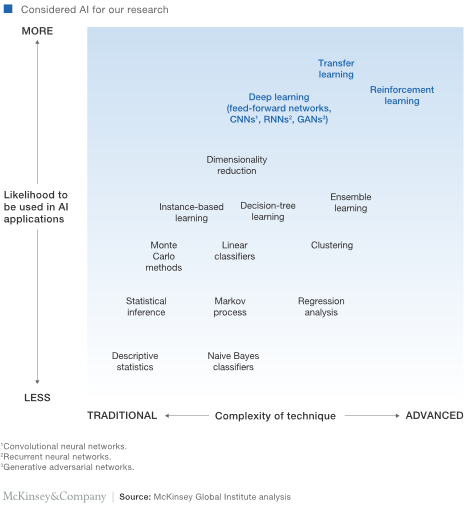Artificial intelligence (AI) stands out as a transformational technology of our digital age—and its practical application throughout the economy is growing apace. For this briefing, Notes from the AI frontier: Insights from hundreds of use cases (PDF–446KB), we mapped both traditional analytics and newer “deep learning” techniques and the problems they can solve to more than 400 specific use cases in companies and organizations. Drawing on McKinsey Global Institute research and the applied experience with AI of McKinsey Analytics, we assess both the practical applications and the economic potential of advanced AI techniques across industries and business functions. Our findings highlight the substantial potential of applying deep learning techniques to use cases across the economy, but we also see some continuing limitations and obstacles—along with future opportunities as the technologies continue their advance. Ultimately, the value of AI is not to be found in the models themselves, but in companies’ abilities to harness them.
It is important to highlight that, even as we see economic potential in the use of AI techniques, the use of data must always take into account concerns including data security, privacy, and potential issues of bias.
- Mapping AI techniques to problem types
- Insights from use cases
- Sizing the potential value of AI
- The road to impact and value

[…]
Implications for stakeholders
As we have seen, it is a company’s ability to execute against AI models that creates value, rather than the models themselves. In this final section, we sketch out some of the high-level implications of our study of AI use cases for providers of AI technology, appliers of AI technology, and policy makers, who set the context for both.
- For AI technology provider companies: Many companies that develop or provide AI to others have considerable strength in the technology itself and the data scientists needed to make it work, but they can lack a deep understanding of end markets. Understanding the value potential of AI across sectors and functions can help shape the portfolios of these AI technology companies. That said, they shouldn’t necessarily only prioritize the areas of highest potential value. Instead, they can combine that data with complementary analyses of the competitor landscape, of their own existing strengths, sector or function knowledge, and customer relationships, to shape their investment portfolios. On the technical side, the mapping of problem types and techniques to sectors and functions of potential value can guide a company with specific areas of expertise on where to focus.
- Many companies seeking to adopt AI in their operations have started machine learning and AI experiments across their business. Before launching more pilots or testing solutions, it is useful to step back and take a holistic approach to the issue, moving to create a prioritized portfolio of initiatives across the enterprise, including AI and the wider analytic and digital techniques available. For a business leader to create an appropriate portfolio, it is important to develop an understanding about which use cases and domains have the potential to drive the most value for a company, as well as which AI and other analytical techniques will need to be deployed to capture that value. This portfolio ought to be informed not only by where the theoretical value can be captured, but by the question of how the techniques can be deployed at scale across the enterprise. The question of how analytical techniques are scaling is driven less by the techniques themselves and more by a company’s skills, capabilities, and data. Companies will need to consider efforts on the “first mile,” that is, how to acquire and organize data and efforts, as well as on the “last mile,” or how to integrate the output of AI models into work flows ranging from clinical trial managers and sales force managers to procurement officers. Previous MGI research suggests that AI leaders invest heavily in these first- and last-mile efforts.
- Policy makers will need to strike a balance between supporting the development of AI technologies and managing any risks from bad actors. They have an interest in supporting broad adoption, since AI can lead to higher labor productivity, economic growth, and societal prosperity. Their tools include public investments in research and development as well as support for a variety of training programs, which can help nurture AI talent. On the issue of data, governments can spur the development of training data directly through open data initiatives. Opening up public-sector data can spur private-sector innovation. Setting common data standards can also help. AI is also raising new questions for policy makers to grapple with for which historical tools and frameworks may not be adequate. Therefore, some policy innovations will likely be needed to cope with these rapidly evolving technologies. But given the scale of the beneficial impact on business the economy and society, the goal should not be to constrain the adoption and application of AI, but rather to encourage its beneficial and safe use.
About the author(s) : Michael Chui is a partner of the McKinsey Global Institute, where James Manyika is chairman and a director; Mehdi Miremadi is a partner in McKinsey’s Chicago office; Nicolaus Henke is a senior partner in the London office; Rita Chung is a consultant in the Silicon Valley office; Pieter Nel is a specialist in the New York office, where Sankalp Malhotra is a consultant.
More: https://www.mckinsey.com/business-functions/mckinsey-analytics/our-insights/an-executives-guide-to-ai